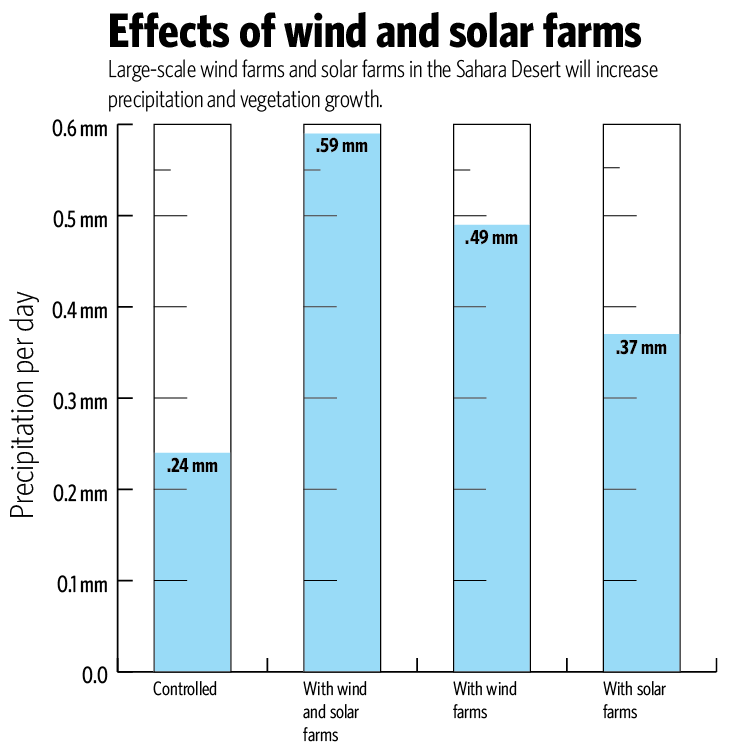Cost deters construction of solar, wind farms
Source: Science Mag
Sep 17, 2018
Large-scale wind and solar farms installed in the Sahara Desert would not only substitute for fossil fuels, but also increase precipitation and vegetation in local regions, University professor Yan Li found in his recent study on the desert’s climate model.
“With the climate model, we can do numerical experiments to study land cover change impact, such as deforestation, as well as the impact of large-scale wind and solar farms on climate,” said Li, postdoctoral research associate in ACES.
The model then showed that wind farms in the Sahara Desert would cause the surface air temperature to significantly increase and would also increase precipitation for as much as 0.25 mm per day. This precipitation would in turn increase vegetation.
“The Sahara is quite dry, and its surface is covered with little vegetation,” Li said. “The additional rainfall and vegetation would certainly provide a much-needed relief to this dry, bare desert. So, I could not think of any downsides.”
Li said the ecological effects of the model should be investigated more in-depth by ecologists.
Get The Daily Illini in your inbox!
Installing solar and wind farms has become increasingly possible; however, installation requires proper planning, visionary decision-making and cooperation of policymakers, companies, stakeholders and people, Li said.
Emmanuel Oyebanji Fadahunsi, co-chair of Energy Working Group, said this study is a mitigative method. This means the study works to reduce the effects of climate change, as opposed to an adaptive method, which is an approach that tries to adapt to the changes that have already occurred.
This is a step in the right direction, because it goes beyond just the generation of energy and looks at its effects, such as vegetation, he said.
“I feel it’s good work, but the question is: why hasn’t it been done?” Fadahunsi said.
Li and Fadahunsi said the main obstacle to implementing these solar and wind farms is cost.
The average cost of a solar panel is around $3 per watt, with an extra $5 to $6 per watt for installation, but it will start to pay the owner back in 10 to 20 years.
Adrian Chendra, chair of Student Sustainability Committee and sophomore in Business, said it also may be hard to convince people to get behind renewable energies, especially if they do not believe that climate change is as dangerous as scientists say it is.
“You can show them the benefits all you want, but if they don’t buy the idea, then you’re never going to be able to achieve the goal,” Chendra said.
However, he said he hopes more students become involved with sustainability, as the health of the planet affects everyone’s life.
Studies and models like this could spark ideas and similar projects in the future, he said.
“It just depends on whether or not the right people meet up, and does that crossroad happen,” Chendra said. “And if it does, then entirely, 100 percent, this could be a full-blown reality for us to enjoy.”
Chendra said he is optimistic of the direction of sustainable businesses and think sustainability will be a huge focus in the future.
“We hope that all these local and global actors and stakeholders could cooperate and make this kind of project a reality,” Li said. “This could be the opportunity for sustaining life on this planet while improving the quality of life for everyone.”






